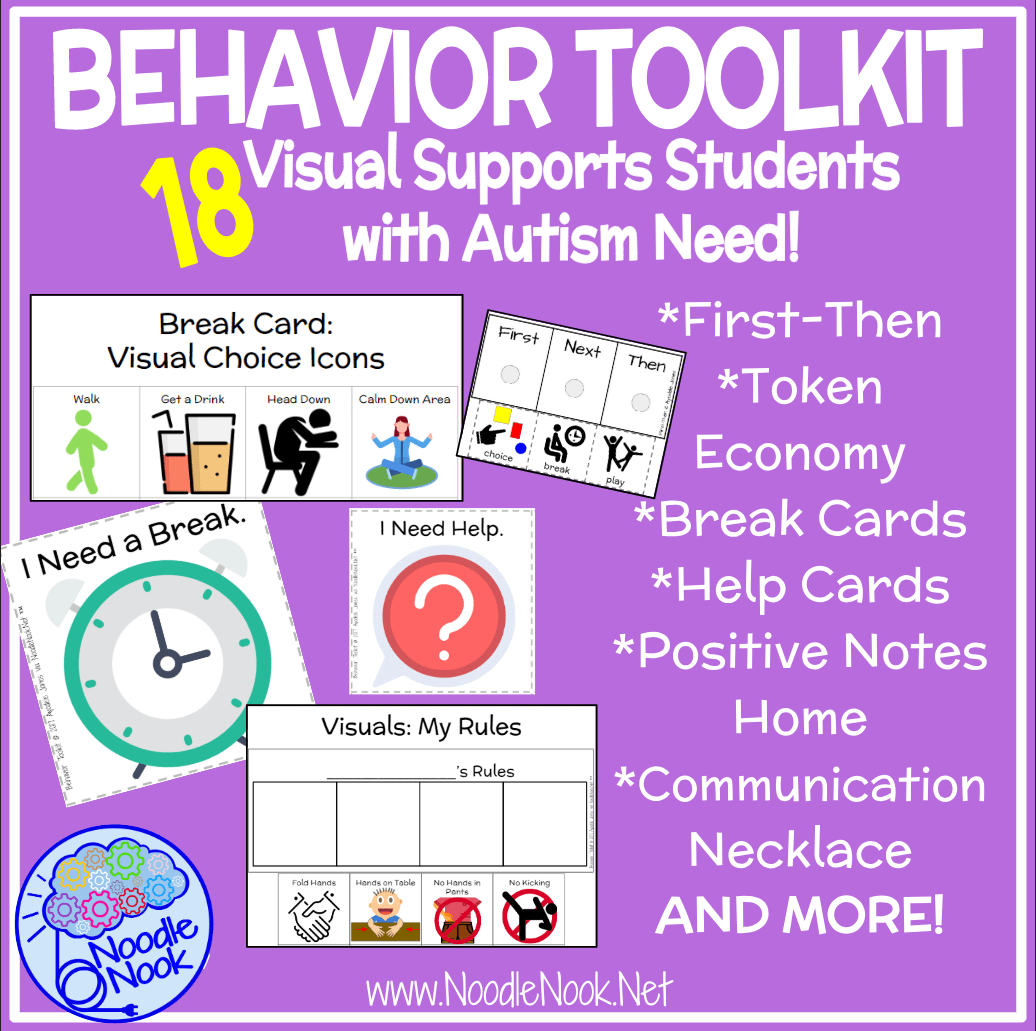
Visual Supports for Behavior Social skills, Behavior management, Classroom behavior
Autism Spectrum Disorders Module: Visual Supports Visual Supports: Cover Sheet Page 1 of 1 National Professional Development Center on ASD. matrix training to teach sociodramatic play to a child with autism. Journal of Positive Behavior Interventions, 6, 238-250. Johnston, S., Nelson, C., Evans, J., & Palazolo, K. (2003). The use of visual.

Visuals for Behavior The Autism Helper
Indiana Resource Center for Autism Browse this collection of v isual supports and other resources to help your students with ASD be successful socially and academically in school. You'll find templates for social rules, classroom rules, emotional support, schedules, and more. Home Reading Topics A-Z Autism Spectrum Disorder

Behavior Visuals for Specials Classes The Autism Helper
Olivia, a preschooler with autism spectrum disorder and the newest addition to Ms. Andersen's morning class, was having a difficult time adjusting to the routine of attending school.. Visual Aids for Positive Behavior Support of Young Children With Autism Spectrum Disorders @article{Kidder2017VisualAF, title={Visual Aids for Positive.

Behavior Toolkit 18 Visuals to Support Students with Autism
October 31, 2022 / in Applied Behavior Analysis (ABA), Autism, Autism Treatment, Autism Treatment For Children / by Leafwing Center When students with autism are in a classroom setting, they often need visuals to help them navigate their daily tasks and learn appropriate behaviors for certain situations.

Printable Behaviour Visuals For Autism Printable World Holiday
Visuals {Behavior Visuals} - The Autism Helper Visuals {Behavior Visuals} Categories: Resources | Visuals An area that visuals will save your little butt is behavior management. Since visuals are so beneficial and helpful for our students - why not use them for the most challenging things - reducing problem behaviors? Genuis right.

Autism Tank 5 Teaching Strategies to Implement in your Autism Classroom
Visual supports are a communication tool that can be used with autistic people. They can be used in most situations, are adaptable and portable. Visual supports can help to: provide structure and routine encourage independence build confidence improve understanding avoid frustration and anxiety provide opportunities to interact with others.

(4) SelfManagement & Emotional/Behavioral Autism visuals, Behavior cards, Social stories autism
Visual supports (VS) are objects or pictures/symbols that can be seen and/or held, which are used to provide information visually to enhance an individual's understanding of: the physical environment; people and the social environment (communication, words, actions, rules and expectations, and spoken or unspoken intentions or expectations) and m.

Visual Behavior Supports Visuals for Behavior Expectations, Goals, Cue Cards Classroom
Autism spectrum disorder (ASD) is lifelong and affects social skills, communication, flexible thinking and behaviour ( Scottish Intercollegiate Guidelines Network (SIGN), 2016 ), underpinned by difficulties with theory of mind, central coherence, executive function, sensory processing and context blindness ( Livingston, Colvert, Social Relations.

Free Printable Visual Cue Cards For Autism
Behavior visual tools are crucial for every classroom because independence is always the goal. These ripping through behavior visuals can help students visualize various strategies. These can help them be successful in the classroom. In my opinion, you can never have too many visuals. The more visuals you provide, the less verbal prompts are needed.

Behavior Management Picture Cards. Freebie Autism visuals, Autism behaviors, Picture cards
Indiana Resource Center for Autism Home Resources Visual Supports Behavior and Emotions Behavior and Emotions This section includes a wide variety of visual supports on the topics from anger management, grief, Incredible 5 Point Scale and a social narrative about winning and losing games. 5 Point Scale - Anxiety

Visuals Snowy Valleys School
TRIAD Outreach and Training. (615) 936-1705 Web: triad.vanderbilt.edu. Tennessee Disability Pathfinder, a free information and referral service for all types of disabilities, all ages, provides information on autism resources external to Vanderbilt. Local (615) 322-8529, (1-800) 640-4636.

A3 Visual Display Behaviour Chart Autism Supplies and Developments
Printable Visuals for Autism 17 FREE Printable visuals for Autism classrooms including printable visual schedules, schedule cards, picture visuals, rules cards, social stories, and token boards all perfect for special education teachers. Get your free printable visuals for SpEd today!

Supporting Positive Behavior Zones of regulation, Self regulation, Social emotional
Visual/spatial intelligence refers to spatial judgment and the ability to visualize with the mind's eye. We use visual intelligence when we navigate space, put together puzzles, memorize maps, and envision the layout of a room. Autistic people are often visual thinkers; certainly, many are very good at puzzles, organizing objects, and.

Visual Helper Special education autism, Special education, Visual supports autism
This issues of NASET's Autism Spectrum Disorder series was written by Sofia M. Borron. A review of literature was completed for articles to evaluate the result of using visual supports for students with Autism Spectrum Disorder (ASD). Children with ASD may display varied social and behavior challenges that affect transitions.

Visuals {Behavior Visuals} The Autism Helper
What exactly is a visual support? Visuals supports can be pictures, objects, sign language or text. They can come in a variety of forms. Some examples of programs that generate visuals are: Boardmaker (Mayer-Johnson) - This popular software generates Picture Communication Symbols (PCS) and other graphics.

Behavior Visuals The Autism Helper
Autism spectrum disorder (ASD) is a lifetime condition that impacts social communicative behavior 1. A core feature of autism is difficulty perceiving and interpreting shifts in eye gaze as.